|
|
Zur Navigationshilfe
BO /contentBottomTemplate
Research interests
Current: Novel High-Temperature-Superconductors: Iron pnictides

Possible symmetries of the order parameter in iron-based superconductors (negative: red, positive: blue)
(Hirschfeld, et al., Rep. Prog. Phys. 74, 124508 (2011))
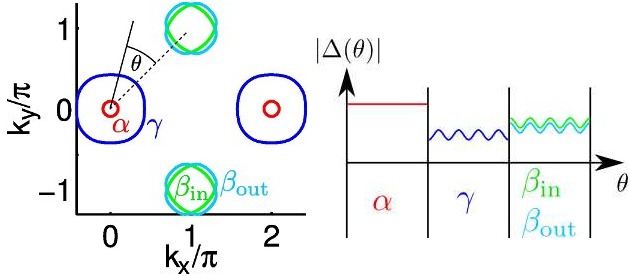
Sketch of the anisotropic order parameter in LiFeAs (ARPES measurement)
(Borisenko, et al., Symmetry 4, 251 (2012))
Although the phenomena of superconductivity has been discovered experimentally more than 100 years ago by Kammerlingh Onnes in 1911, it is still subject to recent research in experiment and theory. A possible reason is that it appears in many different materials and a physical understanding hasn't been achieved in a universal theory yet. The effect of superconductivity which simply speaking manifests itself by complete expulsion of a magnetic field (Meißner effect) and conductance of electric current without loss is due to pairing of electrons to the so-called Cooper pairs. In conventional superconductors (which become superconducting at quite low temperatures below 23K) the attractive interaction is believed to be mediated by lattice vibrations and the essential physics has been understood quite some time ago in terms of the BCS theory.
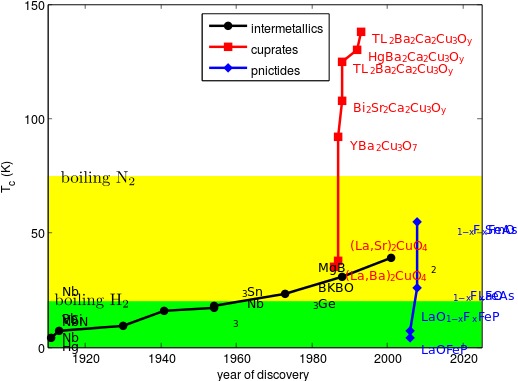
Highest critical temperatures in various materials as function of time
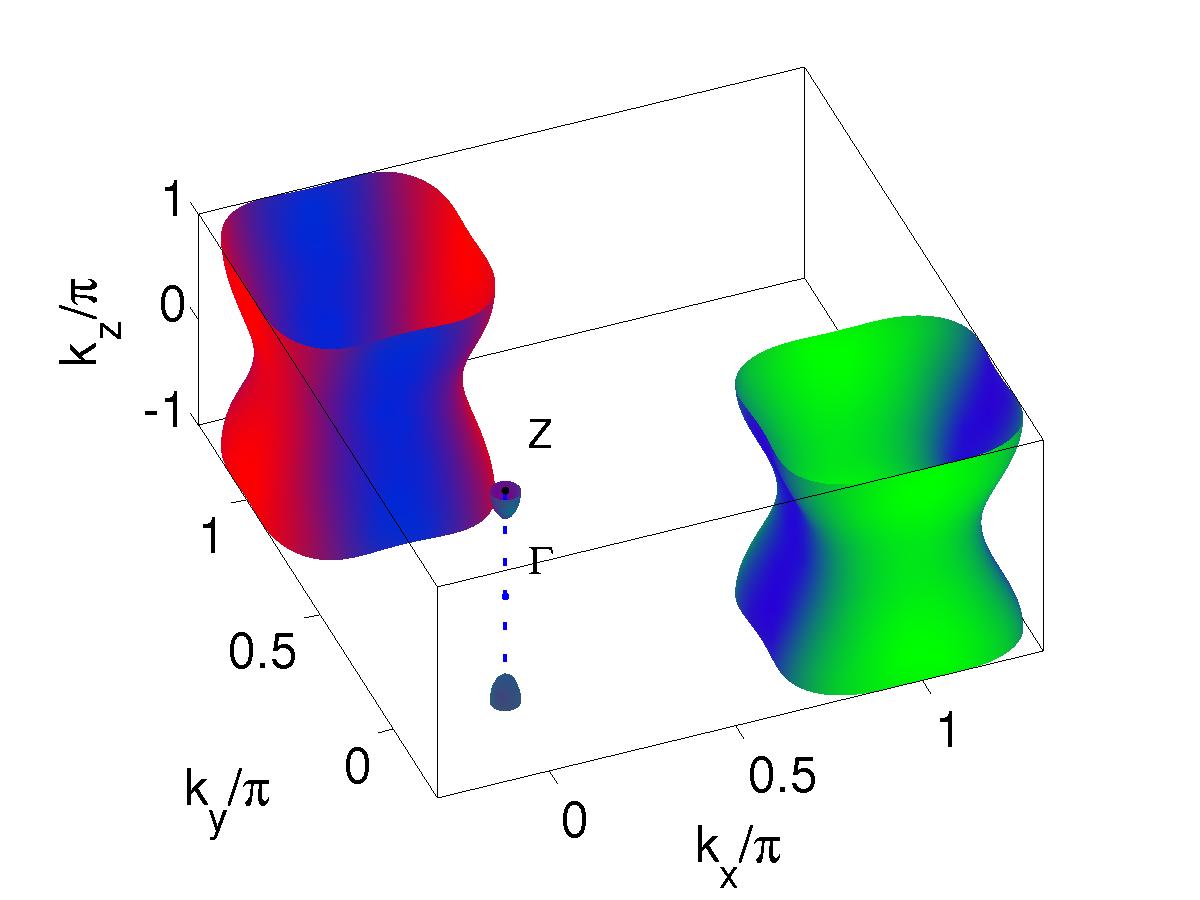
The Fermi surface of KFe2-ySe2 consists in 2 patches centered around the X and Y point (color code: red: dxz orbital, green: dyz orbital, blue: dxy orbital).
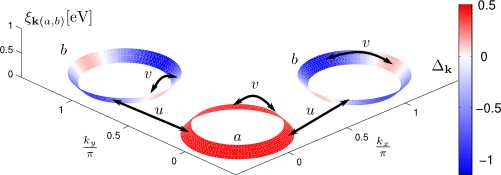
Model of a multiband superconductor with anisotropic order parameter and linearized dispersion.
(Wang, et al., Phys. Rev. B 87, 094504 (2013))
However, the whole understanding got screwed up by two experimental discoveries: In 1986 Bednorz and Müller discovered superconductivity in cuprate materials at such high temperatures where theoretically it shouldn't be possible within the known mechanisms. Up to now the microscopic origin of superconductivity in cuprates is still under debate whereas the materials easily entered into application due to the high transition temperatures above 100K. In 2008 Kamihara and collaborators reported superconductivity in doped iron pnictide materials which added another class of materials that are superconducting at high temperatures up to 55 K. Recently, active research has been carried out in this field because the materials show a rich phase diagram that contains an interplay between superconductivity, magnetism and crystal structure. Among the many known materials there are three compounds which are particularly interesting because they don't fit into the standard paradigm: LiFeAs, KFe2-ySe2 and FeSe (under pressure).
The main questions that we address here are the symmetry of the order parameter and how parameters make a superconductor gaped or gapless. Starting point is the so-called spin fluctuation theory of pairing where the glue of the Cooper pairs is mediated by quantum fluctuations of the electron spins.
Impurities in superconductors
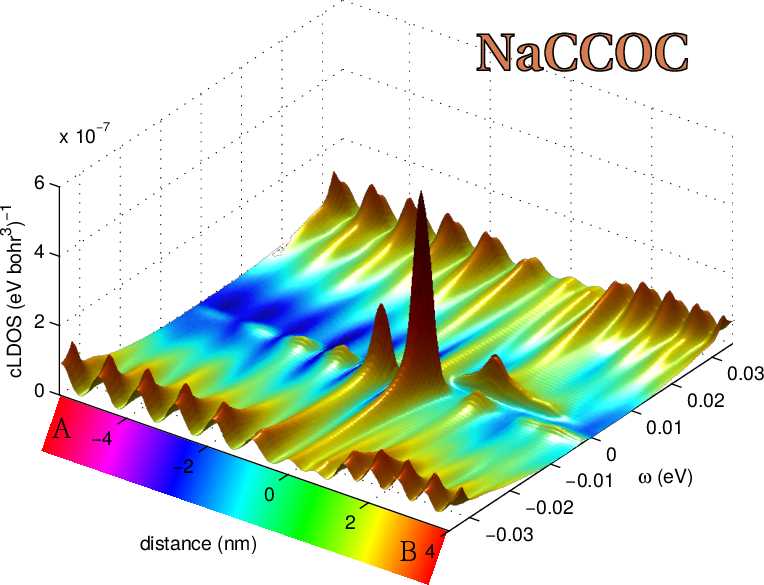
Spatial evolution of the spectra close to a strong impurity in the material NaCCOC
(Choubey, et al., Phys. Rev. B 96, 174523 (2017))
Impurities are often an unwanted property of crystalline systems because they destroy the strict discrete translation symmetry of a crystal. In the case of superconductors, they can however be used to probe the properties of the system. Impurities can be introduced in a controlled way by exposing the crystal to electron irradiation such that the properties of the superconducting order parameter changes as a function of impurity concentration. Another way to observe the implications on impurities is to grow crystals of iron-based superconductors in presence of small concentrations of atoms that substitute for iron atoms and then observe this on the atomic scale with the scanning tunneling microscopy technique.
Superconductivity is a phenomenon that emerges due to the quantum mechanical properties of the electrons which are described by a wavefunction. Within a interference experiment of these waves, one can reveal the structure of this state. Impurities can be used as scattering centers for these waves and the resulting interference phenomena can be observed on the microscopic scale. This method called quasiparticle interference (QPI) delivers information about the electronic system in the normal (non-superconducting) state and the superconducting state with high energetic resolution.
Investigations of the gap structure
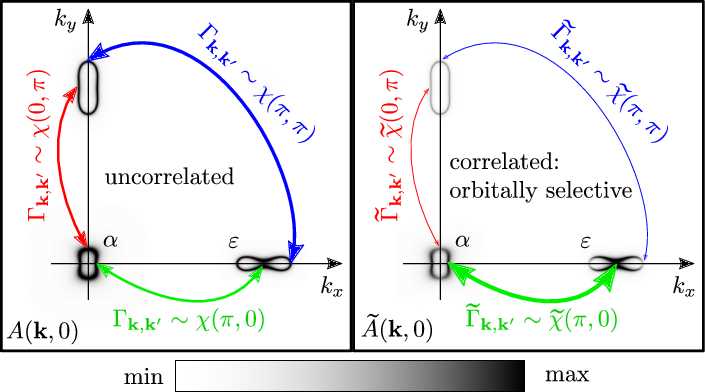
Modification of the pairing interactions (colored arrows) within the orbital selective pairing.
(Kreisel, et al., Phys. Rev. B 95, 174504 (2017))
Proposals for the pairing mechanism that leads to superconductivity, i.e. the glue that binds together electrons to form the Cooper pairs, need to be tested towards expected structures of the order parameter. Theoretically, one starts from a microscopic model for the pairing interaction and calculates for example the excitation gap in the superconducting state. This can be measured directly with spectroscopic probes, or has imprints on thermodynamic quantities as for example specific heat. Comparison to experimental results finally can decide whether the theoretical proposal is compatible with the observations or has to be rejected.
Theory for STM

Theoretically expected tunneling conductance close to a strong impurity in Cuprates within different approximations compared to experimental observations
(Kreisel, et al., Phys. Rev. Lett. 114, 217002 (2015))
The experimental tool of scanning tunneling microscopy delivers spectacular images of conducting surfaces on the atomic scale. It has been used to examine the normal state and the superconducting state of high-Tc materials. However, these materials are layered such that the tunneling out of the surface needs to take into account the wave function of the electronic state when calculating tunneling with sub-atomic resolution.
|
Dissertation: Spin-wave calculations for Heisenberg magnets with reduced symmetry

Corrections to the self energy in second order of the 3-point magnon vertices of the Goldstone magnon
(Dissertation)
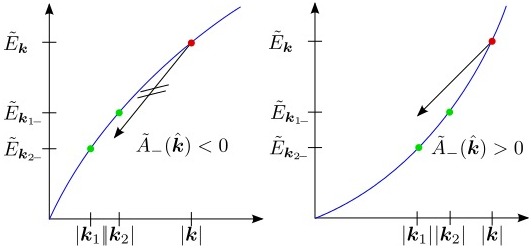
Kinematics determines the possibility of quasiparticle decay: stable quasi particles (left), unstable quasiparticles (right) upon inclusion of 3 magnon scattering
(Dissertation)
The phenomenon of magnetism is a pure quantum effect and has been studied since the beginning of civilization. The practical use of magnetic materials for technical purposes was well established in the 19th century; still nowadays there is no lack of new high-tech applications based on magnetism for example in information technology to store and process data.
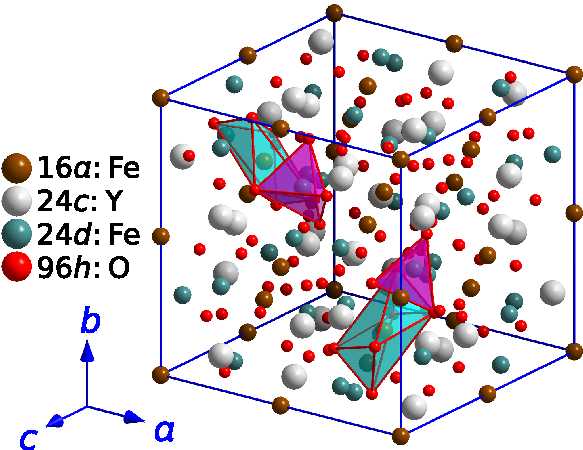
Crystal structure of YIG
(Dissertation)
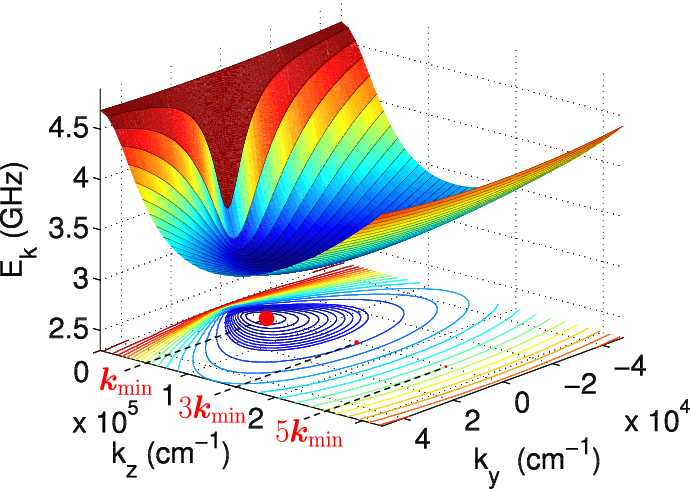
Spin-wave dispersion of the lowest magnon mode in a YIG film: A Bose condensate evolves at the minimum of the dispersion and imposes additional condensates at odd multiples of the momentum at the minimum
(Dissertation)
This thesis does not focus on the development of new applications of magnetism in technology, nor enhancement of known fields of application. Instead, the intention is to use a quantum theory of magnetism for obtaining new insights on physical effects that accompany the phenomenon of magnetism. Therefore three different model systems, each of which are believed to describe a class of real compounds, are considered. Starting from the idea that magnetism can be understood by use of the so-called Heisenberg model that microscopically characterizes the interaction between localized magnetic moments, we restrict ourselves to the case where a long-range magnetic order is present. In order to deduce consequences resulting from this microscopic picture we use the spin-wave theory that is introduced in the first chapter. Central objects of this theory are the magnons which are elementary quantum excitations in ordered magnets.
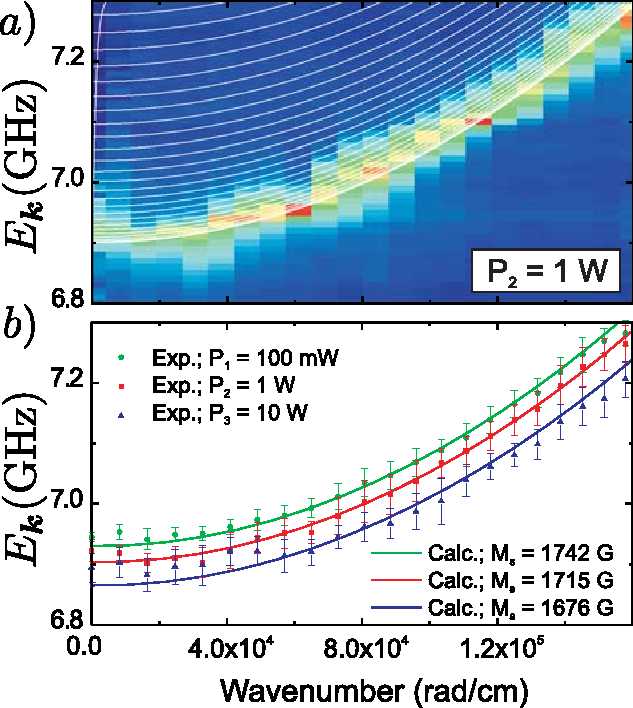
Measured spectrum in YIG for spinwaves traveling parallel to the external magnetic field
(Dissertation)
An application of these mathematical techniques to a model that describes an antiferromagnet in an external magnetic field is presented in the second chapter. Quantities like the spin-wave velocity and the damping of magnons are calculated using a Hermitian operator approach in the framework of spin-wave theory. A strong renormalization of the magnetic excitations arises because the symmetry of the system is reduced due to the external magnetic field.
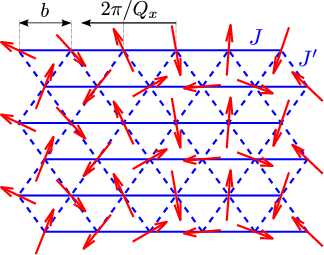
Classical ground state of a frustrated anti-ferromagnet with anisotropy (model for Cesium-Copper-cloride)
(Dissertation)
In the second model system, that describes thin films of a ferromagnet, concepts of classical physics meet quantum physics: The magnetic dipole-dipole interaction that is also known in everyday life from the magnetic forces between magnets and was initially formulated in the theory of electromagnetism, is included in the microscopic model. Having a special compound in mind where the magnetic excitations are directly accessible in experiments, the energy dispersions of magnon modes in thin-film ferromagnets are deduced. Our approach is essentially a basis for further investigations beyond this thesis to describe strong correlations and condensation of magnons. A recent realization of data processing devices with spin waves puts the understanding of physical processes in these ferromagnetic films in the focus of upcoming research.
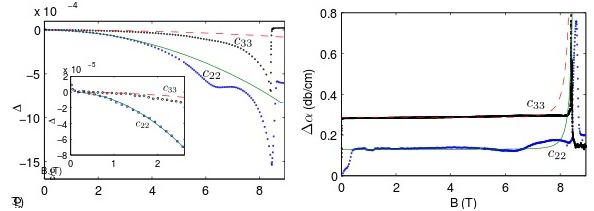
Sound velocity and damping in Cesium-Copper-cloride as a function of the external magnetic field
(Dissertation)

Measurement of the sound velocity and damping in a crystal using the pulse-echo technique
(Disputation)
The third model system brings in the so-called frustration where the interactions between the spins are such that the total energy cannot be minimized by an appropriate alignment of the magnetic moments in the classical picture. In the simplest case this appears because the antiferromagnetically coupled spins are located on a triangular lattice. This situation will lead to strong quantum fluctuations which make this model system interesting. Finally the overall symmetry is reduced by inclusion of spin anisotropies and an external magnetic field. Instead of focusing on the properties of the magnetic excitations, the effect of the magnetic field on the properties of the lattice vibrations is subject to the investigation. This is interesting because the characteristics of lattice vibrations can be measured experimentally using the supersonic technique.
Fulltext available
|
|
Diploma thesis: Spin-wave interactions in quantum antiferromagnets
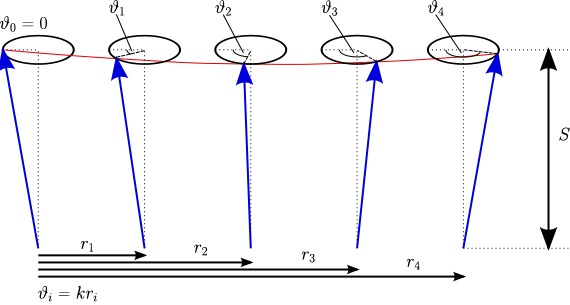
Spin wave in a ferromagnet
(Diploma thesis)
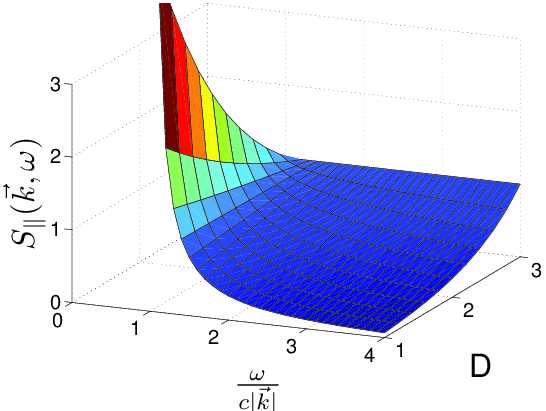
Staggered structure factor of an anti-ferromagnet in arbitrary dimension
(Diploma thesis)
Magnetic properties of materials are well known since the days of antiquity when the Greeks described the ion ore. These materials called ferromagnets are widely used in our everyday life for example in electric apparatus. In ferromagnets the magnetic moments of the atoms involved are aligned in a parallel way. Therefore one can observe an macroscopic magnetization outside the solid.
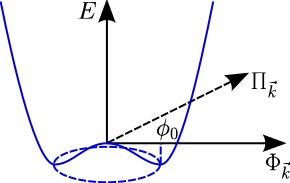
Order parameter emerging at spontaneous symmetry breaking described in Hermitean parametrization
(Diploma thesis)
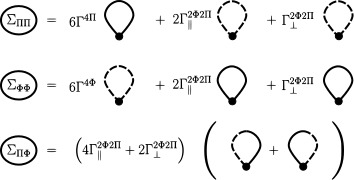
Diagrammatic visualization of the corrections to the self energy in Hermitean parametrization
(Diploma thesis)
In the case of the anti-ferromagnet this is different: An anti parallel alignment leads to a cancellation of the total magnetic moment and it is not possible to directly observe magnetic forces. These materials are nevertheless featuring properties due to the underlying magnetism. I calculated some of these properties in my diploma thesis.
content (German only)
diploma thesis (German only)
|
|
Research Stays Abroad
Publications
|
Y. Mizukami, M. Konczykowski, Y. Kawamoto, S. Kurata, S. Kasahara, K. Hashimoto, V. Mishra, A. Kreisel, Y. Wang, P. J. Hirschfeld, Y. Matsuda, T. Shibauchi
Nat. Commun. 5, 5657 (2014)
Disorder-induced topological change of the superconducting gap structure in iron pnictides |
|
Shun Chi, Ramakrishna Aluru, Udai Raj Singh, Ruixing Liang, Walter N. Hardy, D. A. Bonn, A. Kreisel, Brian M. Andersen, R. Nelson, T. Berlijn, W. Ku, P. J. Hirschfeld, Peter Wahl
Phys. Rev. B 94, 134515 (2016)
Impact of Iron-site defects on Superconductivity in LiFeAs |
|
A. Kreisel, R. Nelson, T. Berlijn, W. Ku, Ramakrishna Aluru, Shun Chi, Haibiao Zhou, Udai Raj Singh, Peter Wahl, Ruixing Liang, Walter N. Hardy, D. A. Bonn, P. J. Hirschfeld, Brian M. Andersen
Phys. Rev. B 94, 224518 (2016)
Towards a quantitative description of tunneling conductance of superconductors: application to LiFeAs |
|
Peter O. Sprau, Andrey Kostin, Andreas Kreisel, Anna E. Böhmer, Valentin Taufour, Paul C. Canfield, Shantanu Mukherjee, Peter J. Hirschfeld, Brian M. Andersen, J.C. Séamus Davis
Science, 357, 75 (2017)
Discovery of Orbital-Selective Cooper Pairing in FeSe,
Preprint Version |
|
Shun Chi, Ramakrishna Aluru, Stephanie Grothe, A. Kreisel, Udai Raj Singh, Brian M. Andersen, W. N. Hardy, Ruixing Liang, D. A. Bonn, S. A. Burke, Peter Wahl
Nat. Commun. 8, 15996 (2017)
Imaging the Real Space Structure of the Spin Fluctuations in an Iron-based superconductor |
|
S. L. Holm, A. Kreisel, T. K. Schäffer, A. Bakke, M. Bertelsen, U. B. Hansen, M. Retuerto, J. Larsen, D. Prabhakaran, P. P. Deen, Z. Yamani, J. O. Birk, U. Stuhr, Ch. Niedermayer, A. L. Fennell, B. M. Andersen, K. Lefmann
Phys. Rev. B 97, 134304 (2018)
Magnetic ground state and magnon-phonon interaction in multiferroic h-YMnO3 |
|
Andrey Kostin, Peter O. Sprau, Andreas Kreisel, Yi Xue Chong, Anna E. Böhmer, Paul C. Canfield, Peter J. Hirschfeld, Brian M. Andersen, J.C. Séamus Davis
Nature Materials 17, 869 (2018)
Visualizing Orbital-selective Quasiparticle Interference in the Hund's Metal State of FeSe,
arXiv version |
|
Pabitra K. Biswas, Andreas Kreisel, Qisi Wang, Devashibhai T. Adroja, Adrian D. Hillier, Jun Zhao, Rustem Khasanov, Jean-Christophe Orain, Alex Amato, Elvezio Morenzoni
Phys. Rev. B 98, 180501 (2018)
Evidence of nodal gap structure in the basal plane of the FeSe superconductor |
|
Tong Chen, Youzhe Chen, Andreas Kreisel, Xingye Lu, Astrid Schneidewind, Yiming Qiu, J. T. Park, Toby G. Perring, J Ross Stewart, Huibo Cao, Rui Zhang, Yu Li, Yan Rong, Yuan Wei, Brian M. Andersen, P. J. Hirschfeld, Collin Broholm, Pengcheng Dai
Nat. Mater. 18, 709 (2019)
Anisotropic spin fluctuations in detwinned FeSe
PDF
Supplement
|
|
Jia-Xin Yin, Songtian S. Zhang, Guangyang Dai, Yuanyuan Zhao, Andreas Kreisel, Gennevieve Macam, Xianxin Wu, Hu Miao, Zhi-Quan Huang, Johannes H. J. Martiny, Brian M. Andersen, Nana Shumiya, Daniel Multer, Maksim Litskevich, Zijia Cheng, Xian Yang, Tyler A. Cochran, Guoqing Chang, Ilya Belopolski, Lingyi Xing, Xiancheng Wang, Yi Gao, Feng-Chuan Chuang, Hsin Lin, Ziqiang Wang, Changqing Jin, Yunkyu Bang, M. Zahid Hasan
Phys. Rev. Lett. 123, 217004 (2019)
Quantum phase transition of correlated iron-based superconductivity in LiFe1−xCoxAs |
|
Rahul Sharma, Andreas Kreisel, Miguel Antonio Sulangi, Jakob Böker, Andrey Kostin, Milan P. Allan, H. Eisaki, Anna E. Böhmer, Paul C. Canfield, Ilya Eremin, J.C. Séamus Davis, P.J. Hirschfeld, Peter O. Sprau
npj Quantum Materials 6, 7 (2021)
Multi-Atom Quasiparticle Scattering Interference for Superconductor Energy-Gap Symmetry Determination |
|
J.-X. Yin, Y. Y. Zhao, Zheng Wu, X. X. Wu, A. Kreisel, B. M. Andersen, Gennevieve Macam, Sen Zhou, Rui Wu, Limin Liu, Hanbin Deng, Changjiang Zhu, Yuan Li, Yingkai Sun, Zhi-Quan Huang, Feng-Chuan Chuang, Hsin Lin, C. -S. Ting, J. -P. Hu, Z. Q. Wang, P. C. Dai, H. Ding, S. H. Pan
arXiv:2011.07701
Role of anion in the pairing interaction of iron-based superconductivity |
|
A. Kreisel, C. A. Marques, L. C. Rhodes, X. Kong, T. Berlijn, R. Fittipaldi, V. Granata, A. Vecchione, P. Wahl, P. J. Hirschfeld
npj Quantum Mater. 6, 100 (2021)
Unveiling the missing band: Quasiparticle Interference of the γ-band in Sr2RuO4 |
|
Sananda Biswas, Andreas Kreisel, Adrian Valadkhani, Matteo Dürrnagel, Tilman Schwemmer, Ronny Thomale, Roser Valentí, Igor I. Mazin
Phys. Rev. B 108, L020501 (2023)
Hybrid s-wave superconductivity in CrB2 |
|
Hanbin Deng, Guowei Liu, Z. Guguchia, Tianyu Yang, Jinjin Liu, Zhiwei Wang, Yaofeng Xie, Sen Shao, Haiyang Ma, William Liège, Frédéric Bourdarot, Xiao-Yu Yan, Hailang Qin, C. Mielke III, R. Khasanov, H. Luetkens, Xianxin Wu, Guoqing Chang, Jianpeng Liu, Morten Holm Christensen, Andreas Kreisel, Brian Møller Andersen, Wen Huang, Yue Zhao, Philippe Bourges, Yugui Yao, Pengcheng Dai, Jia-Xin Yin
Nat. Mat. 23, 1639 (2024)
Evidence for time-reversal symmetry-breaking kagome superconductivity |
|
Jinwon Lee, Sanghun Lee, Andreas Kreisel, Jens Paaske, Brian M. Andersen, Koen M. Bastiaans, Damianos Chatzopoulos, Genda Gu, Doohee Cho, Milan P. Allan
Nano Lett., 25, 11, 4227 (2025)
Signatures of Amorphous Shiba State in FeTe0.55Se0.45
Nano Letters (2025) |
|
Alessandro De Vita, Chiara Bigi, Davide Romanin, Matthew D. Watson, Vincent Polewczyk, Marta Zonno, François Bertran, My Bang Petersen, Federico Motti, Giovanni Vinai, Manuel Tuniz, Federico Cilento, Mario Cuoco, Brian M. Andersen, Andreas Kreisel, Luciano Jacopo D'Onofrio, Oliver J. Clark, Mark T. Edmonds, Christopher Candelora, Muxian Xu, Siyu Cheng, Alexander LaFleur, Tommaso Antonelli, Giorgio Sangiovanni, Lorenzo Del Re, Ivana Vobornik, Jun Fujii, Fabio Miletto Granozio, Alessia Sambri, Emiliano Di Gennaro, Jeppe B. Jacobsen, Henrik Jacobsen, Ralph Ernstorfer, Ilija Zeljkovic, Younghun Hwang, Matteo Calandra, Jill A. Miwa, Federico Mazzola
arXiv:2502.20010
Optical switching in a layered altermagnet |
|
Talks
|
DPG-Frühjahrstagung 2007 Regensburg
session: TT 31.5
Thu 29.03.2007, 18:45-19:00, H19
Probing anomalous longitudinal fluctuations of the interacting Bose gas via Bose-Einstein condensation of magnons
slides |
|
Ruperto Carola Symposion Heidelberg: Ultracold Quantum Gases
18-20 July 2007
Bose-Einstein condensation and spin-wave interactions in quantum antiferromagnets
slides |
|
DPG-Frühjahrstagung 2008 Berlin
session: TT 24.11
Wed 27.02.2008, 16:45-17:00, H2053
Hybrid approach for quantum antiferromagnets in a uniform magnetic field: Application
slides |
|
DPG-Frühjahrstagung 2009 Dresden
Session: MA 17.10
Wed 25.03.2009, 12:30-12:45, HS04
Microscopic theory of spin waves in ferromagnetic films
slides |
|
University of São Paulo (USP)
Thu 19.11.2009, 14:30-15:30
Spin-Wave Theory for Magnetic Insulators
From textbook knowledge towards BEC of magnons
slides
abstract |
|
DPG-Frühjahrstagung 2010 Regensburg
Session: TT 30.8
Thu 25.03.2010, 11:30-11:45, H20
Spin-Phonon Interactions in triangular Antiferromagnets
slides |
|
Workshop "Ultracold Quantum Gases Beyond Equilibrium", 2010 Natal, Rio Grande do Norte, Brasilien
Tue 28.09.2010, 11:50-12:10
Bose Einstein Condenation at finite momentum
slides
Longer Version, held on 17.09.2010 at Instituto Internacional da Física, Natal
slides |
|
Korrelationstage 2011, Dresden
Fri 04.03.2011, 9:25-9:50
Magnon-phonon interactions in triangular antiferromagnets
slides |
|
Disputation: Spin-wave calculations for Heisenberg magnets with reduced symmetry
Thu 14.07.2011, 14:00-14:20
Spin-wave calculations for Heisenberg magnets with reduced symmetry
slides
|
|
APS March Meeting 2012, Boston, MA
Tue 28.02.2012, 15:30-15:42
Time-dependent spin-wave theory
slides |
|
APS March Meeting 2013, Baltimore, MD
Tuesday, 19.03.2013, 12:39-12:51
Pairing strength and gap functions in multiband superconductors: 3D effects
slides |
|
Condensed matter group seminar, The Niels Bohr Institute, University of Copenhagen, Denmark
Thursday, 24.10.2013, 13:15
Spin-waves and BEC in thin-film ferromagnets; Spin fluctuation pairing and symmetry of the order parameter in KxFe2-ySe2
slides |
|
DPG-Frühjahrstagung 2014 Dresden
Session: TT 92.5
Thursday 03.04.2014, 16:00-16:15, HSZ 201
Spin fluctuations and superconductivity in KxFe2-ySe2
slides |
|
Correlations & Coherence at different scales, 2014, Ustroń, Poland
Monday 08.09.2014, 17:20-17:40
Visualization of atomic-scale phenomena in superconductors
slides |
|
APS March Meeting 2015, San Antonio, TX
Thursday, March 5, 2015, 3:06 PM–3:18 PM
Interpretation of scanning tunneling quasiparticle interference and impurity states
slides |
|
DPG-Frühjahrstagung 2015 Berlin
Session: DF 10.10
Wednesday, March 18, 2015, 12:00–12:15, EB 107
Magnon-phonon interactions in hexagonal multiferroic YMnO3
Contribution |
|
20th International Conference on Magnetism, Barcelona
Tuesday, July 7 2015, 12:30-12:45
Magnon-phonon interactions in hexagonal multiferroic YMnO3
Contribution |
|
Physics of Interfaces and Layered Structures, Stockholm
Monday, September 7 2015, 11:00
Visualization of atomic-scale phenomena in superconductors
slides |
|
ITF-Seminar, Leibnitz Institut für Festkörper- und Werkstoffforschung, Dresden
Monday, October 19 2015,15:00
Interpretation of scanning tunneling quasiparticle interference and impurity states
|
|
DPG-Frühjahrstagung 2016 Regensburg
Session TT 46.7
Wednesday, March 09 2016 12:00-12:15, H19
Superconductivity and spin excitations in orbitally ordered FeSe
Contribution
Session O 81.3
Thursday, March 10 2016 11:15-11:30, H4
Simulating atomic-scale phenomena on surfaces of unconventional superconductors
Contribution
|
|
APS March Meeting 2016, Baltimore, MD
Session P11.7
Wednesday, March 16 2016, 16:06-16:18
Superconductivity and spin excitations in orbitally ordered FeSe
Contribution
|
|
5th International Conference on Superconductivity and Magnetism 2016
Tuesday, April 26 2016, 11:45-12:05
Spin Excitations in a Model of FeSe with Orbital Ordering
slides
|
|
ITF-Seminar, Leibnitz Institut für Festkörper- und Werkstoffforschung, Dresden
August 16 2016, 11:00-12:00
Towards a realistic simulation of disorder in unconventional superconductors
slides
|
|
BSCCOfest, Department of Physics, University of Florida, Gainesville, FL
December 16 2016, 10:30-11:00, NPB 2165
Realistic simulation of tunneling in STM for cuprates
slides
|
|
Condensed Matter Theory Seminar, Institut für Theoretische Physik, Universität Frankfurt
Februar 10 2017, 15:15
Orbital-Selective Pairing and Gap Structures of Iron-Based Superconductors
slides
|
|
APS March Meeting 2017, New Orleans, LA
Monday, March 13 2017, 14:42-14:54
Towards a quantitative description of tunneling conductance of superconductors
slides
|
|
DPG-Frühjahrstagung 2017 Dresden
Thursday, March 23 2017, 15:00–15:30, HSZ 103
New Developments in the Theory of STM on Unconventional Superconductors
Contribution
slides
|
|
Condensed Matter Seminar, School of Physics and Astronomy, University of St. Andrews, Scotland, April 26 2017, 12:00
Orbital-Selective Pairing in FeSe
Slides
|
|
Seminar der Theorie der kondensierten Materie, RWTH Aachen, 18. July 2017, 15:00
Orbital-Selective Pairing in iron-based superconductors
|
|
Condensed matter seminar at KIT, Karlsruhe Institute of Technology, 20. February 2018, 11:00
Theory of STM in Unconventional Superconductors
Slides
|
|
APS March Meeting 2018, Los Angeles, CA
Monday, March 5th 2018, 11:51-12:03
Consequences of Orbital Selectivity for Magnetism and Superconductivity in Fe-based Superconductors
Abstract
Slides
|
|
DPG-Frühjahrstagung 2018 Berlin
Tuesday, March 13th 2018, 11:30–11:45, A 053
Consequences of Orbital Selectivity for Magnetism and Superconductivity in Fe-based Superconductors
Contribution
Slides
|
|
International Workshop: New Developments in STM on Surfaces of Functional Materials, TDLI, Shanghai
Tuesday, 28. August, 2018, 16:15-16:50
Wannier-based Theory of Unconventional Superconductivity
Slides
|
|
Department of Physics, Tsinghua University, Bejiing
Thursday, 30. August, 2018, 10:30-11:30
Orbital-Selective Electrons in Iron-Based Superconductors
|
|
APS March Meeting 2019, Boston, MA
Tuesday, March 5th 2019, 8:24-8:36
Itinerant approach to magnetic neutron scattering of FeSe: effect of orbital selectivity
Abstract
|
|
DPG-Frühjahrstagung 2019 Regensburg
Monday, April 1st 2019, 10:30-10:45
Magnetic fluctuations in FeSe: effect of orbital selectivity
Abstract
Monday, April 1st 2019, 17:30-18:00
Theory of superconducting pairing in iron-based superconductors
Abstract
|
|
Itinerant magnetism and superconductivity 2019 - 3rd International Conference GRK 1621, Dresden
Montag, 09. September, 2019, 10:20-10:55
Superconducting pairing in iron-based superconductors: Beyond the s± theme
|
| |